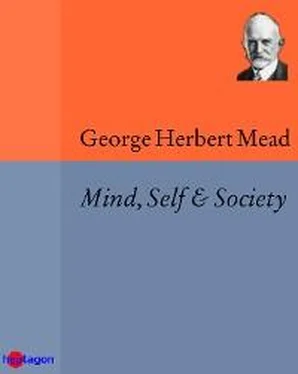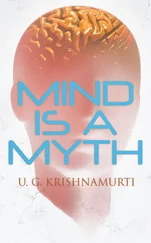George Herbert Mead - Mind, Self & Society
Здесь есть возможность читать онлайн «George Herbert Mead - Mind, Self & Society» — ознакомительный отрывок электронной книги совершенно бесплатно, а после прочтения отрывка купить полную версию. В некоторых случаях можно слушать аудио, скачать через торрент в формате fb2 и присутствует краткое содержание. Жанр: unrecognised, на английском языке. Описание произведения, (предисловие) а так же отзывы посетителей доступны на портале библиотеки ЛибКат.
- Название:Mind, Self & Society
- Автор:
- Жанр:
- Год:неизвестен
- ISBN:нет данных
- Рейтинг книги:3 / 5. Голосов: 1
-
Избранное:Добавить в избранное
- Отзывы:
-
Ваша оценка:
- 60
- 1
- 2
- 3
- 4
- 5
Mind, Self & Society: краткое содержание, описание и аннотация
Предлагаем к чтению аннотацию, описание, краткое содержание или предисловие (зависит от того, что написал сам автор книги «Mind, Self & Society»). Если вы не нашли необходимую информацию о книге — напишите в комментариях, мы постараемся отыскать её.
Mind, Self & Society — читать онлайн ознакомительный отрывок
Ниже представлен текст книги, разбитый по страницам. Система сохранения места последней прочитанной страницы, позволяет с удобством читать онлайн бесплатно книгу «Mind, Self & Society», без необходимости каждый раз заново искать на чём Вы остановились. Поставьте закладку, и сможете в любой момент перейти на страницу, на которой закончили чтение.
Интервал:
Закладка:
What, for example, is our experience that answers to clenching of the fist? Physiological psychology followed the action out through the nerves that came from the muscles of the arm and hand. The experience of the act would then be the sensation of what was going on; in consciousness as such there is an awareness of what the organ was doing; there is a parallelism between what goes on in the organ and what takes place in consciousness. This parallelism is, of course, not a complete parallelism. There seems to be consciousness corresponding only to the sensory nerves. We are conscious of some things and not conscious of others, and attention seems to play a very great part in determining which is the case. The parallelism which we carry over does not seem to be complete, but one which occurs only at various points. The thing that is interesting here is that it is the organism that now provides the clew for the analysis. Only portions of the response appear in consciousness as such. The organism has assumed the primary place. Experimental psychology started off from what it could get hold of in the physiological system, and then undertook to find out what in consciousness seemed to answer to it. The scientist felt that he had the same assurance that the physiologist had in identifying these facts in the nervous system, and given those facts he could look into consciousness. It was simpler to start off with the neurosis and then register what was found in the psychosis. Thus, the acceptance of some sort of a parallelism between the contents of consciousness and the physiological processes of the central nervous system led to a conception of those contents dynamically, in terms of acts, instead of statically, in terms of states. In this way the contents of consciousness were approached from below (that is, naturalistically) rather than from above (that is, transcendentally), by a study of the physiological processes of the central nervous system to determine what in the mind answers to the activities of the physiological organism.
There was a question as to the directive centers for unified action. We are apt to think of the central nervous system from the point of view of the telephone board, with calls coming in and responses going out. Certain centers come to be conceived as principal centers. If you go back to the base of the brain, to that portion which is the essence of the central nervous system of lower forms, you do find an organization there which controls in its activity other activities; but when you come to conduct in the human form, you fail to find any such system in which there is a single directive center or group of centers. One can see that the various processes which are involved in running away from danger can be processes which are so interrelated with other activities that the control comes in the organization. One sees the tree as a possible place of escape if a bull is after him; and in general, one sees things which will enable the ongoing activity to be carried out. A varying group of centers may be the determining factor in the whole activity of the individual. That is the concept which has also been carried over into the field of growth. Certain parts of the embryo start growing, and control the action of growth until some other process comes into control. In the cortex, that organ which in some sense answers to human intelligence, we fail to find any exclusive and unvarying control, that is, any evidence of it in the structure of the form itself. In some way we can assume that the cortex acts as a whole, but we cannot come back to certain centers and say that this is where the mind is lodged in thinking and in action. There are an indefinite number of cells connected with each other, and their innervation in some sense leads to a unitary action, but what that unity is in terms of the central nervous system it is almost impossible to state. All the different parts of the cortex seem to be involved in everything that happens. All the stimuli that reach the brain are reflected into all parts of the brain, and yet we do get a unitary action. There remains, then, a problem which is by no means definitely solved: the unity of the action of the central nervous system. Wundt undertook to find certain centers which would be responsible for this sort of unity, but there is nothing in the structure of the brain itself which isolated any parts of the brain as those which direct conduct as a whole. The unity is a unity of integration, though just how this integration takes place in detail we cannot say.
What I wanted to bring out is that the approach to psychological theory from the standpoint of the organism must inevitably be through an emphasis upon conduct, upon the dynamic rather than the static. It is, of course, possible to work in the other direction, that is, to look at experience from the point of view of the psychologist and to draw conclusions as to what must go on in the central nervous system. It is possible to recognize, for example, that we are not simply at the mercy of the different stimuli that play in the central nervous system – the natural view of the physiologist. We can see these organs adjust themselves to different types of stimuli. When air waves come in they affect the particular organs of the ear; when tastes and odors come in the stimuli get to tracts in the proper organs that respond. There may seem to be merely a response of the organism to the stimuli. This position is taken over into the psychology of Spencer, who accepted the Darwinian principle of evolution. The influence of environment is exercised over the form, and the adaptation of the form results from the influences of the environment on it. Spencer conceived of the central nervous system as being continually played upon by stimuli which set up certain paths, so that it was the environment which was fashioning the form.
The phenomena of attention, however, give a different picture of conduct. The human animal is an attentive animal, and his attention may be given to stimuli that are relatively faint. One can pick out sounds at a distance. Our whole intelligent process seems to lie in the attention which is selective of certain types of stimuli. Other stimuli which are bombarding the system are in some fashion shunted off. We give our attention to one particular thing. Not only do we open the door to certain stimuli and close it to others, but our attention is an organizing process as well as a selective process. When giving attention to what we are going to do we are picking out the whole group of stimuli which represent successive activity. Our attention enables us to organize the field in which we are going to act. Here we have the organism as acting and determining its environment. It is not simply a set of passive senses played upon by the stimuli that come from without. The organism goes out and determines what it is going to respond to, and organizes that world. One organism picks out one thing and another picks out a different one, since it is going to act in a different way. Such is an approach to what goes on in the central nervous system which comes to the physiologist from the psychologist.
The physiology of attention is a field which is still a dark continent. The organism itself fits itself to certain types of conduct, and this is of considerable importance in determining what the animal will do. There also lie back in the organism responses, such as those of escape from danger, that represent a peculiar sensitivity. A sound in some other direction would not have the same effect. The eye is very sensitive to motions that lie outside of the field of central vision, even though this area of the retina of the eye is not so sensitive to form and distinctions of color. You look for a book in a library and you carry a sort of mental image of the back of the book; you render yourself sensitive to a certain image of a friend you are going to meet. We can sensitize ourselves to certain types of stimuli and we can build up the sort of action we are going to take. In a chain set of responses the form carries out one instinctive response and then finds itself in the presence of another stimulus, and so forth; but as intelligent beings we build up such organized reactions ourselves. The field of attention is one in which there must be a mechanism in which we can organize the different stimuli with reference to others so that certain responses can take place. The description of this is something we can reach through a study of our own conduct, and at present that is the most that we can say.
Читать дальшеИнтервал:
Закладка:
Похожие книги на «Mind, Self & Society»
Представляем Вашему вниманию похожие книги на «Mind, Self & Society» списком для выбора. Мы отобрали схожую по названию и смыслу литературу в надежде предоставить читателям больше вариантов отыскать новые, интересные, ещё непрочитанные произведения.
Обсуждение, отзывы о книге «Mind, Self & Society» и просто собственные мнения читателей. Оставьте ваши комментарии, напишите, что Вы думаете о произведении, его смысле или главных героях. Укажите что конкретно понравилось, а что нет, и почему Вы так считаете.












